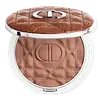What's inside
What's inside
 Key Ingredients
Key Ingredients

 Benefits
Benefits

 Concerns
Concerns

 Ingredients Side-by-side
Ingredients Side-by-side

Synthetic Fluorphlogopite
Silica
AbrasiveSorbitan Isostearate
EmulsifyingC30-45 Alkyl Dimethicone
Skin ConditioningButyrospermum Parkii Butter
Skin ConditioningC20-24 Alkyl Dimethicone
Skin ConditioningCaprylyl Glycol
EmollientIris Florentina Root Extract
MaskingEthylhexylglycerin
Skin ConditioningParfum
Masking1,2-Hexanediol
Skin ConditioningPentaerythrityl Tetra-Di-T-Butyl Hydroxyhydrocinnamate
AntioxidantTriethoxycaprylylsilane
Water
Skin ConditioningC20-24 Olefin
Skin ConditioningAscorbyl Glucoside
AntioxidantMica
Cosmetic ColorantColeus Barbatus Root Extract
Skin ConditioningIsoeugenyl Acetate
PerfumingLinalyl Acetate
MaskingAlumina
AbrasiveKaolin
AbrasiveTocopherol
AntioxidantHyaluronic Acid
HumectantZinc Stearate
Cosmetic ColorantGlycerin
HumectantAnt Egg Oil Extract
Vanillin
MaskingSodium Benzoate
MaskingPotassium Sorbate
PreservativeCI 77491
Cosmetic ColorantCI 77492
Cosmetic ColorantCI 77499
Cosmetic ColorantCI 77891
Cosmetic ColorantCI 77007
Cosmetic ColorantSynthetic Fluorphlogopite, Silica, Sorbitan Isostearate, C30-45 Alkyl Dimethicone, Butyrospermum Parkii Butter, C20-24 Alkyl Dimethicone, Caprylyl Glycol, Iris Florentina Root Extract, Ethylhexylglycerin, Parfum, 1,2-Hexanediol, Pentaerythrityl Tetra-Di-T-Butyl Hydroxyhydrocinnamate, Triethoxycaprylylsilane, Water, C20-24 Olefin, Ascorbyl Glucoside, Mica, Coleus Barbatus Root Extract, Isoeugenyl Acetate, Linalyl Acetate, Alumina, Kaolin, Tocopherol, Hyaluronic Acid, Zinc Stearate, Glycerin, Ant Egg Oil Extract, Vanillin, Sodium Benzoate, Potassium Sorbate, CI 77491, CI 77492, CI 77499, CI 77891, CI 77007
Mica
Cosmetic ColorantAlumina
AbrasiveZinc Stearate
Cosmetic ColorantCaprylic/Capric Triglyceride
MaskingMethylpropanediol
SolventOctyldodecyl Stearoyl Stearate
EmollientCaprylyl Glycol
EmollientSodium Dehydroacetate
PreservativeTocopheryl Acetate
AntioxidantPhenylpropanol
MaskingCI 19140
Cosmetic ColorantCI 77491
Cosmetic ColorantCI 77499
Cosmetic ColorantCI 77891
Cosmetic ColorantCI 15850
Cosmetic ColorantIngredients Explained
These ingredients are found in both products.
Ingredients higher up in an ingredient list are typically present in a larger amount.
Alumina is another name for the compound aluminum oxide. It is used as a thickener, absorbent, and abrasive.
As an absorbent, alumina can give a mattifying effect. It is used in mineral sunscreens to help coat nano-sized filters, such as titanium dioxide. By increasing the size of the UV filters, these ingredients stay on the skin for a longer time. By coating small sized ingredients, alumina helps thicken a product.
Alumina may be used as an abrasive, or exfoliant.
Alumina is naturally occurring in the mineral corundum. Certain varieties of corundum create rubies and sapphires. Corundum is also the crystalline form of alumina.
Learn more about AluminaCaprylyl Glycol is a humectant and emollient, meaning it attracts and preserves moisture.
It is a common ingredient in many products, especially those designed to hydrate skin. The primary benefits are retaining moisture, skin softening, and promoting a healthy skin barrier.
Though Caprylyl Glycol is an alcohol derived from fatty acids, it is not the kind that can dry out skin.
This ingredient is also used as a preservative to extend the life of products. It has slight antimicrobial properties.
Learn more about Caprylyl GlycolCi 77491 is also hydrated iron III oxide. It's sole purpose is to give a red/pink hue to products.
Iron III oxides are classified as inorganic chemicals for coloring.
Synthetically created Ci 77491 is considered safer than those naturally found. This is because the synthetically created version may contain less impurities. Iron oxides are generally non-toxic and non-allergenic.
Learn more about CI 77491Ci 77499 is also hydrated iron III oxide. It is created from mixing red and black iron oxides. This helps give shades of darkness to a product.
Iron III oxides are classified as inorganic chemicals for coloring.
Ci 77891 is a white pigment from Titanium dioxide. It is naturally found in minerals such as rutile and ilmenite.
It's main function is to add a white color to cosmetics. It can also be mixed with other colors to create different shades.
Ci 77891 is commonly found in sunscreens due to its ability to block UV rays.
Learn more about CI 77891Mica is a naturally occurring mineral used to add shimmer and color in cosmetics. It can also help improve the texture of a product or give it an opaque, white/silver color.
Serecite is the name for very fine but ragged grains of mica.
This ingredient is often coated with metal oxides like titanium dioxide. Trace amounts of heavy metals may be found in mica, but these metals are not harmful in our personal products.
Mica has been used since prehistoric times throughout the world. Ancient Egyptian, Indian, Greek, Roman, Aztec, and Chinese civilizations have used mica.
Learn more about MicaZinc Stearate is the metal salt of stearic acid. It is a white solid used to bind, thicken, and lubricate products.
This ingredient is common in powder makeup, where it helps keep the powder together.
Zinc Stearate is hydrophobic and repels water.
This ingredient can be sourced from non-animal or animal sources. It is best to reach out to the brand to see where they source this ingredient from.
Learn more about Zinc Stearate